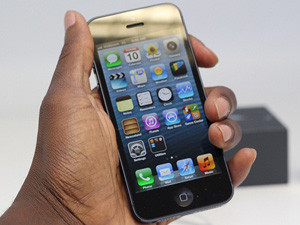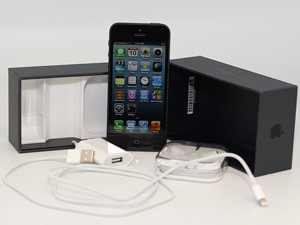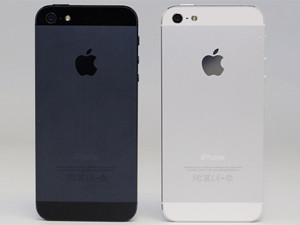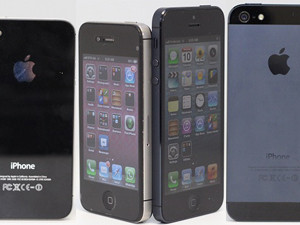
This time last year, I had taken my first tentative steps away from my beloved BlackBerry and moved over to an iPhone 4S.
Since embracing the iOS platform, I was admittedly sucked into the hype and anticipation around the impending release of the iPhone 5 throughout most of 2012, but I was also among those who felt somewhat disappointed by the final announcement. The fact that it was just bigger, thinner and lighter under-whelmed me.
While many felt that same disappointment back with the iPhone 4S, that device was the first iPhone I'd ever actually used and I was suitably impressed and considered it to easily be ahead of even the strongest competition at the time. But a lot has happened in the smartphone space since the iPhone 4S hit the market. In fact, a lot has happened even between the iPhone 5 being unveiled by Apple and the device actually becoming available in SA.
Some have called it a 'miracle', while others erred on the side of 'meh'. So now, after a month of availability locally, and four months since its debut, just how good is the iPhone 5? And for an iPhone 4S user, is it worth the upgrade?
Look and feel
Starting with the all-important look and feel of the iPhone 5 - much like its predecessors, there is an undeniable sense of holding a device that is of a higher quality than the average smartphone. First impressions are everything, and out of the box, the iPhone 5 feels great in the hand. It also carries on the basic design ethic of previous iterations and there is no mistaking that you are holding an iPhone.
I found the black and slate model that I had to review exuded subtle elegance and extreme attention to detail. The body of the phone is made of anodised aluminium and pigmented glass (which gives the two-tone effect on the back). To be honest, I think the white and silver model would be my first choice, but the black version is still a great-looking device.
Without getting swept up in the Apple rhetoric around the design, even some of the most devoted Android fans I know agreed that, with the iPhone 5, Apple shows its strengths. "It just feels like it's of a higher quality," was a comment I heard over and over again as the iPhone 5 was passed around among friends and family.

That said, while the iPhone 5 feels like a higher-quality device than most competitors', for existing iPhone users, the lightness of it can take some getting used to, especially for those who actually liked the weighty feel of the glass back. The smoothness of the finish together with the lightness of the handset also makes it quite prone to slipping right out of one's hand. While I was too nervous (and broke) to attempt a serious drop test, the iPhone 5 managed to survive slipping out of my hand without any shattered glass or serious scuffs.
Speaking of scuffs, there was the so-called "scuff-gate" saga that saw new iPhone 5 users taking to social networks to report scuffs, scratches and chips on their brand new handsets. There have also been some general complaints about how easily the body, and especially the edges of the phone, can show wear and tear from normal use. While I was wary of this, I don't think I was overly cautious and I didn't use a cover for most of the time I had the phone, and I can't say I noticed any scuffs. The aluminium back did get full of fingerprints and looked quite dirty quite easily though. Because of this, and for peace of mind, I would recommend using a cover.
iTaller
Slimmer body and lightness aside, the other key design change in the iPhone 5 is obviously the larger (or longer) screen. The screen size was one of my disappointments when the specs were initially revealed. Images of the handset also made me wonder if it would seem unnaturally elongated with the screen only being lengthened (from 3.5 inches to four inches) and not widened. But when you actually have the phone in your hand, the screen size does make a lot of sense. Yes, it seems narrow, and compared to the phablet trend, it's positively 'pokey'. But it's comfortable, and while occasionally a little manoeuvring is needed to reach the top-left corner, the iPhone 5 remains a device that suits one-handed use - something the majority of other high-end smartphones have moved away from, but which some users, like myself, are yet to warm up to.

Personally, I still prefer to be able to comfortably hold my phone in one hand when typing messages and browsing. The new display size also makes the aspect ratio 16:9, which, when compared to that of the iPhone 4S, is better for both game playing and video viewing. However, for users who use their phones primarily for those purposes, the 4.3- to 4.5-inch displays of competing devices will undoubtedly blow the iPhone 5 out of the water.
In terms of actual display quality, the Retina display of the iPhone 5 is exceptionally crisp. Colours also appear to be more natural, vivid and smooth than they do on the 4S (which is actually quite dull by comparison) - blacks are blacker, blues and bluer, and it's just noticeably better to look at.
Ageing OS
When it comes to the actual OS, having upgraded to iOS 6 on my 4S as soon as the update was available, the interface remains identical on the iPhone 5. Having had the opportunity to play with Windows Phone 8, BlackBerry 10 and even Jelly Bean to some extent, I have to say that iOS is definitely starting to feel a bit stale.
Of course, it remains highly intuitive and simple (and I believe one cannot overstate the importance of simplicity when it comes to a mobile OS), but it does feel a bit static compared to other platforms. In reality, the rows of app icons (even now with the extra row of icons on the added screen realty) don't bring anything new to the table. They still require the user to put in the work to get them to come to life and show the information users are looking for. For users already within the Apple ecosystem though, the continuity across devices is obviously a key advantage.
With iOS 6 comes the infamous Apple Maps app. Of course, as even Apple itself has said, the app is far from where it should be. Over time, it promises it will get better, but thankfully in the meantime, there's the Google Maps app. Having other options available is great, but there is a certain disappointment that the out-of-the-box software is not all up to scratch.
Maps aside, the addition of Facebook integration with iOS 6 is a welcome feature. As with Twitter, users can link to their accounts directly through the OS, allowing for direct updates via the notification centre, direct posting of photos and syncing of contact lists. I found this to be easily the standout feature of iOS 6 - but again, since the OS is available on the previous iPhone models, it's not a differentiator for the iPhone 5. That said, the Facebook experience on the iPhone 5 is a far smoother and quicker one overall, thanks to the faster processor (more about that later).
Another new app in iOS 6 is Passbook, which is obviously a very unfortunate name choice for an app in the context of SA. While the iPhone 5 doesn't have NFC, Passbook acts as a digital wallet for documents that can be scanned, like boarding passes, concert tickets and vouchers. Unfortunately, there is little to no support for this in SA, and until local service providers jump on the bandwagon, there's little one can actually do with the app. Overall, iOS 6 is a welcome improvement (Maps not included in that statement), but it doesn't change anything about the core iPhone experience. What is different though is the performance of iOS 6 when it is paired with the hardware of the iPhone 5 - and it's that cohesion that competitors still fail to achieve.
Performance
It's the hardware within the iPhone 5 that really sets it apart from its predecessors. The A6 processor promises twice the performance, and it delivers. I put the new iPhone up against the 4S on a number of tasks, including launching apps, taking pictures, browsing the Web and playing YouTube videos, and in all cases, the iPhone 5 was noticeably faster and smoother. Even Siri was speedier in her responses. Overall, it definitely offered one of the fastest, most seamless smartphone experiences I've ever had and made the device a real pleasure to use.
While the iPhone 5 is LTE-capable, this was something I wasn't able to test since Apple is yet to enable the feature locally despite our carriers having switched on their LTE networks in some areas.
In terms of battery life, I found the iPhone 5 to be marginally better than the iPhone 4S. I could easily get a standard full day's use out of it and not necessarily be on 1% and racing towards a charger at the end of the day, as is the case with my iPhone 4S. By the same time of day, the iPhone 5 would still have between 20% to 30% charge left.
Camera
Back when I decided to go with the iPhone 4S over the Samsung Galaxy Nexus, it was really the camera that was the killer feature for me. While the iPhone 5 camera remains at 8MP, the performance is noticeably improved over the 4S, especially in low-light conditions and when using the flash. While some photos on the 4S would often appear over-exposed and using the flash at night would add a smoky haze to the images, photos on the iPhone 5 have better white balance and overall colour.

There were many complaints about the so-called 'purple haze' in pictures taken into direct light with the iPhone 5, but this was not something that appeared to be a problem for me while using the review phone (or maybe I don't take enough pictures into direct light?). Regardless, overall, the iPhone 5's picture quality was an improvement on those taken on my 4S.
Taking pictures is also faster and the phone's ability to focus automatically has been enhanced. The panorama mode is a welcome addition (albeit a bit late considering it's been available on other platforms for some time), but generally, Apple could still offer a lot more in terms of camera features (keeping in mind that Jelly Bean 4.2 has features like photo sphere). Video quality was also good using the rear-camera, although I can't say I noticed any significant difference between videos shot on the 4S and the 5.
The improved 1.2MP front-facing camera also performs better than that of the 4S, and is especially useful for FaceTime chats, but the image is still quite grainy. Speaking of FaceTime, with iOS 6, users can now make video calls on the service over 3G - another welcome update.
Other features
Of course, when it comes to any iPhone, it would be remiss of me not to mention the music features, and in the iPhone 5's case, there are also the new Ear Plugs. When these were first revealed, I wondered if a redesign of the earphones was really necessary. But having tried them, I have a new dislike for traditional earphones and their now obviously non-ergonomic design that would lead to them becoming uncomfortable to wear over long periods (maybe I just have oddly-shaped ears?). The Ear Plugs slide perfectly into place and actually stay there. They fit comfortably and can be worn for long periods - after some time, you hardly even notice they're there.
The design functions to simultaneously shut out external noise (at least more so than standard earphones) and channel sound into the ear canal. The difference in sound quality is substantial, and Ear Plugs are now easily my earphones of choice. Also, with the iTunes Music store recently becoming available in SA, the process of downloading, storing and listening to music is seamless (perhaps a bit more seamless than my credit card would like).
One small annoyance I had with the iPhone 5 was the Lightening connector. While I can understand why Apple has decided to move towards a smaller connector, given the fact that I haven't yet forked out the necessary cash for a new 30-pin adaptor, this proved to be somewhat of an inconvenience. Because of this, I couldn't use the handset with any of my docking stations, and finding cables to charge it when I'd forgotten mine at home was a futile exercise. This will no doubt change over time as Lightening connectors become the norm for Apple devices, but for now, I remain annoyed.
In a nutshell
All in all, the iPhone 5 is an exceptionally good-looking phone; it outperforms its predecessors and the more one uses it, the more one enjoys it. The software and hardware work together to create a seamless smartphone experience. However, while it presents a compelling case to upgrade for iPhone 4 and below users, I'm not convinced iPhone 4S users are missing out on a great deal.
It's an evolutionary device that will keep Apple fans happy, but may not be compelling enough to draw in consumers from other platforms. The fact remains that specifications at the high end of smartphones have levelled out - and while the design and performance of the iPhone 5 may be a cut above the rest, the actual features are par for the course, and for many, may even fall short when there are comparable, less-expensive handsets on the market.
Video: See what ITWebbers think of the iPhone 5 here.
Contract for 16GB iPhone 5 | Price | Airtime | SMSes | Data |
8ta Smart Contract Basic S | R358 | - | 25 | 450MB |
Vodacom Smart Light | R399 | 75 off-peak | 100 | 100MB |
Cell C Straight Up 200 | R399 | 200 anytime | 200 | 500MB |
8ta Smart Contract 1 | R408 | 15 anytime; 90 on-net | 10 | 350MB |
MTN AnyTime 200 | R429 | R200 | 25 | 250MB |
Vodacom Smart Standard 229 | R449 | 75 anytime, 20 More weekend | 150 | 150MB |
8ta Smart Contract 3 | R458 | 60 anytime; 230 on-net | 50 | 500MB |
Vodacom Smart Standard | R499 | 130 anytime, 60 More weekend | 300 | 300MB |
Vodacom iPhone Everyday Off-Peak | R499 | 120 off-peak | 50 off-peak | 250MB |
iPhone 5 specifications | |
Connectivity | HSPA+, CDMA, 4G LTE |
WiFi | 802.11 a/b/g/n on 2.4GHz and 5GHz |
Bluetooth | 4.0 |
SIM | Nano-SIM |
Body | Aluminium and glass Black/Slate or White/Silver |
Dimensions | 123.8 x 58.6 x 7.6mm |
Weight | 112g |
Screen size | 4 inches |
Display | 1136 x 640 Retina Display, 326ppi |
Memory | 16/32/64 GB storage, 1GB RAM |
Processor | Apple A6 |
Camera | Rear-camera: 8MP, 3264 x 2448 pixels, autofocus, LED flash, LED video, 1080p@30fps, video stabilisation, geo-tagging Front camera: 1.2MP, 720p@30fps, face detection, FaceTime over WiFi or cellular |
Battery | Non-removable Li-Po 1440 mAh battery (5.45 Wh). Up to eight hours' 3G talk time |
Other features | iMessage, Siri, Facebook and Twitter integration, iCloud integration |
Share